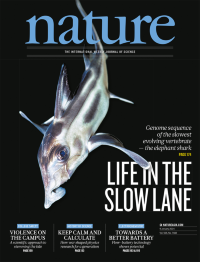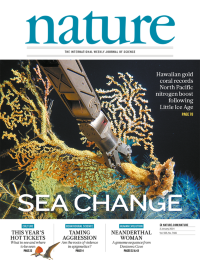Volume 505
-
No. 7485 30 January 2014
A century after Max von Laue received a Nobel prize for discovering the diffraction of X-rays by crystals, X-ray crystallography has made its mark in almost every field of science. In this special issue, Nature celebrates the International Year of Crystallography by examining the impact of von Laues method and its descendants. Cover: Viktor Koen.
-
No. 7484 23 January 2014
Abstract representation of the complex folds of the protein and RNA components of the large subunit of the mammalian mitochondrial ribosome, by Basil Greber after Keith Haring. The mitochondria that power eukaryotic cells via aerobic respiration originated from prokaryotes and contain a much-reduced genome that encodes a number of RNA molecules and a very limited subset of mitochondrial proteins. The mitochondrial ribosomes, or mitoribosomes, of mammalian cells are highly specialized for the translation of membrane proteins of the respiratory chain. Nenad Ban and colleagues have solved the three-dimensional structure of the large 39S mitoribosomal subunit by cryoelectron microscopy to 4.9 å resolution. Their images provide detailed insights into the considerable changes that have occurred in this ribosome, presumably to help facilitate translation of the very hydrophobic proteins encoded by the mitochondrial genome. Cover: Basil Greber
-
No. 7483 16 January 2014
Northern bald ibises flying in V formation during a human-led migratory flight. Some bird species have refined their flying skills to the extent that they can fly in near-perfect V, but why they adopt such a tactic has been a matter of conjecture. One suggestion is that by flying in a V the birds are able to minimize energy costs, and now an analysis of data captured from free-flying migratory ibises suggests that there are energetic benefits. The data also reveal a sophisticated and dynamic process of in-flight control. Birds in the V phase their wing-beats to path-match, allowing a trailing bird to exploit the aerodynamic upwash from the bird in front. A bird flying directly behind, however, flaps with opposite phasing in order to minimize the detrimental downwash from the leaders wings. All this must require the birds to have developed a range of phasing strategies to cope with the dynamic wakes produced by flapping wings. Cover: Markus Unsd.
Insight
-
No. 7482 9 January 2014
The elephant shark (Callorhinchus milii) is a cartilaginous fish native to the temperate waters off southern Australia and New Zealand, living at depths of 200 to 500 metres and migrating into shallow waters during spring for breeding. The genome sequence is published in this issue of Nature. Comparison with other vertebrate genomes shows that it is the slowest evolving genome of all known vertebrates � coelacanth included. Genome analysis points to an unusual adaptive immune system lacking the CD4 receptor and some associated cytokines, indicating that cartilaginous fishes possess a primordial gnathostome adaptive immune system. Also absent are genes encoding secreted calcium-binding phosphoproteins, in line with the absence of bone in cartilaginous fish. Cover: Rudie Kuiter/OceanwideImages.com
-
No. 7481 2 January 2014
The deep-sea Hawaiian gold coral Kulamanamana haumeaae pictured in its living habitat during a NOAA/HURL Pisces V submersible dive. K. haumeaae is a remarkably long-lived species, sometimes attaining ages of thousands of years. Over the millennia these corals provide a unique geochemical time-series as they convert sinking phytoplankton and other tiny particles into a proteinaceous coral skeleton. Primary productivity in the North Pacific subtropical gyre has increased in recent decades despite a decline in nutrient supply. An ecosystem shift towards nitrogen-fixing plankton communities has been put forward as a possible explanation, but the cause for this shift remains unclear. Owen Sherwood and colleagues use nitrogen isotopic (15N) records from K. haumeaae corals to establish that the increase in nitrogen fixation had already began around 150 years ago, and that it may have been linked to Northern Hemisphere climate change since the end of the Little Ice Age. Cover image: NOAA Hawaii Undersea Research Laboratory, DSRV Pisces Pilot Max Cremer, 2004





